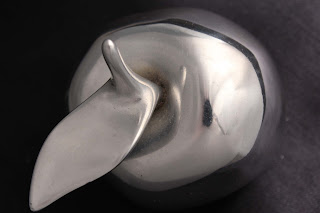Initially I was going to photograph a chrome letter plate, as it was flat and very shiny. However, I found the width rather awkward when it came to making the tracing paper cone. I decided a smaller object would be better for this exercise. Although not flat, this chrome paper weight in the shape of an apple seemed a good choice. Also, its roughly round shape and varying curves represented more of a challenge than a totally flat surface.
The subject was placed on a black cotton sheet atop a small table with the camera, on a tripod, fixed above.
 |
2013.04.27.ChromeApple (1)
f/14 1/80 ISO - 400 |
The tungsten light source, with no diffuser, was held close to the camera, above the subject. The surface of the metal is unappealing and dull. Also, the glare of the light reflected in the metal surface is unsatifactory, along with reflection of my hand.
 |
2013.04.27.ChromeApple (2)
f/9 1/100 ISO-400 |
Using some tracing paper (A3) taped together, I made a cone of sorts and placed the wide end surrounding the subject, with the other end around the sides of the camera lens. The light was moved to directly right of the subject. The top areas look a lot more apealing, but the sides strucj directly by the light look dull and don't blend well. There is less glare, and just a small reflection of the camera.
 |
2013.04.27.ChromeApple (3)
f/9 1/160 ISO-400 |
The light was moved directly behind and to the right, the subject adjusted slightly. The different angles of the surface's contours have reduced the reflection of the camera to a very small dot. The surface texture is improved, although the right and bottom sides of the subject are still not right.
 |
2013.04.27.ChromeApple (4)
f/9 1/250 ISO-400 |
The light was moved directly behind. This made the edges darker, blending more into the background. However, the top surface areas are dulled.
 |
2013.04.27.ChromeApple (5)
f/9 1/30 ISO-400 |
The light was raised much higher (1.5-2m), positioned slightly to the left and behind. The different contours of the surface are shown quite well, although the midtones on parts of the left edge look a bit odd. There is some reflection of the camera, my hand and a support beneath the "leaf".
 |
2013.04.27.ChromeApple (6)
f/5.6 /1/25 ISO-400 |
An umbrella diffuser was attached to the light, which was kept at the same hight but moved more to the left. The surface has less of a metallic look to it now.
 |
2013.04.27.ChromeApple (7)
f/5.6 1/80 ISO-400 |
The umbrella was removed and the light positioned directly above. Unwanted reflections now appear around the right side edges towards the top.
 |
2013.04.27.ChromeApple (8)
f/5.6 1/400 ISO-400
|
I lowered the light to about 30cm above the camera, and to the left. The image is quite pleasing, with good tonal variations, showing the shape, and with no reflections.
 |
2013.04.27.ChromeApple (9)
f/8 1/400 ISO-400 |
The light was lowered further, to about 10cm above the camera and as close as possible. The subject was rotated round slightly for a better composition and to remove the shadow beneath the leaf. I'm happy with this as the final image.
What I can learn from this exercise is that the light source should be large than the subject, when it has a shiny surface. The best results also come from the light facing the subject directly, although I think this mayalso work with a light source below a diffused background, such as milky perspex.






















































+(1).jpg)
+(2).jpg)